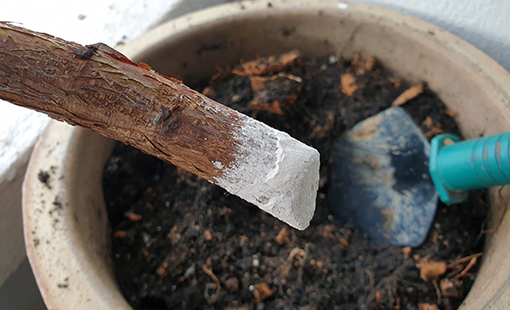
How to Use Rooting Hormone
Using a rooting hormone to propagate plant cuttings increases the success rate. Taking a cutting from a plant and growing it produces a new plant identical to the parent plant. This is a reliable and inexpensive way to propagate your favorite plants and the best way to grow new difficult-to-propagate plants. Stem cuttings are the most common method, but plants can also be grown from root cuttings and leaf cuttings.
What Is Rooting Hormone?
Rooting hormone products are chemicals that stimulate root growth, typically on plant cuttings. The instructions described here assume a powered rooting hormone but you can also purchase it gel or liquid forms.
When a rooting hormone is used correctly, it causes a plant cutting to develop roots quickly and be more robust than cuttings that don’t. Most gardeners use rooting hormone primarily on ornamental plants and to propagate succulents. You can purchase rooting hormone at local garden centers or order it online from a garden supply company.
Which Cuttings Can You Use?
The rooting hormone works on a variety of cuttings, including new growth, woody stems, leaves and roots and dramatically increases the odds of successful propagation. If the plant produces blooms, wait until the blooms fade before taking the cutting. Rooting new plants from parents requires patience, and the cuttings are fragile before the root system develops. In general, keep the planting medium moist but not wet and provide light but no direct sun.
Using Rooting Hormone on a Stem Cutting
Use a clean knife or shears to remove a fresh, healthy stem cutting from a parent plant. The parent must be vigorous and healthy, and make sure the growing tip is between three to eight inches long. Cut the topmost few inches from the stem. Make the cut near a node, which is a slightly swollen knob on the stem. Remove any leaves or flowers from the node area.
- Moisten the bottom few inches of the cutting so the rooting hormone can adhere to it.
- Pour some rooting hormone into another clean vessel and dip (or roll) the bottom few inches of the cutting into it. Do not dip the cutting directly into the original rooting hormone container. Don’t apply the rooting hormone any higher than the final planting depth of the cutting. Shake off the excess powder by lightly tapping the cutting against the edge of the container.
- Plant the cutting in a soilless potting medium. Make a hole in the potting medium with a pencil or similar tool. Make sure the planting hole is wide enough so that the rooting hormone is not rubbed off as you sink the cutting into the soil.
- Tamp down the soil around the cutting to remove any air pockets. Water lightly (a spray bottle works well), and keep the cutting warm at 60F or higher. Root systems develop best when the cutting is not placed in direct sunlight.
Working With Leaf Cuttings
Some plants, such as many succulents, don’t have stems. However, you can propagate them through leaf cuttings. Depending on the leaf structure, apply the rooting hormone to the part of the leaf that was closest to the center of the plant and cover it with a soilless potting mix. Push the leaf partway into the mix.
If the leaf has a short stem, as is the case with African violets, dip the stem in rooting hormone and plant it in the potting soil just like you do with stem cuttings, by sinking the stem up to the leaf into the potting mix.
In some cases, it is necessary to cover the backside of the leaves with the rooting hormone and lay them on top of the moist soilless mix and lightly press down until the leaf touches the potting medium.
Keep all rooting plants out of the direct sun until they have developed a robust root system.
Working With Root Cuttings
Root cuttings are just that: pieces of the root of a parent plant that will eventually produce a new plant. Fall is the best time of year to take root cuttings so that the root cutting has the entire winter to produce a new plant in time for spring.
- Remove soil from the root area of the parent plant.
- Cut 2-inch pieces of slender roots and re-cover the root area of the parent plant.
- Roll the root cuttings in the rooting hormone and plant them shallow in the potting medium.
- Keep the medium moist but not wet.
Information courtesy of TheSpruce.com

 Adams Fairacre Farms
Adams Fairacre Farms